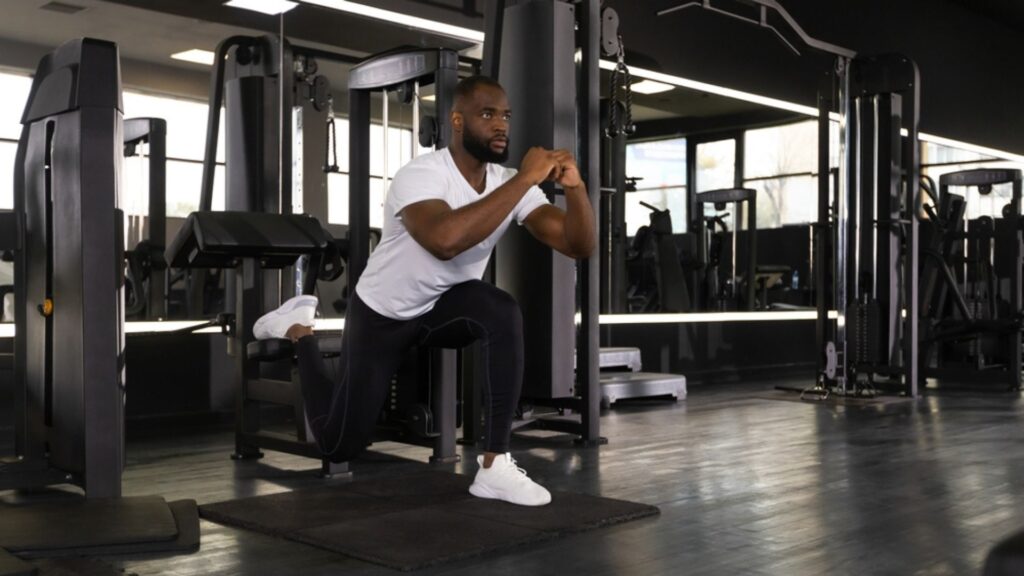A series of effective exercises to add to your fitness regime in preparation for hiking…
Training for hiking can greatly improve your overall experience, and utilizing the gym to achieve these gains is one of the most effective ways to accomplish this. Hiking is not only about walking; it involves navigating uneven terrain, steep inclines, and carrying extra weight.
Physical fitness is as crucial as packing the right gear when it comes to enjoying a safe and satisfying hike. A well-rounded gym routine can enhance your stamina, strengthen the key muscles used in hiking, and help you maintain balance on tricky trails, giving you confidence on challenging terrains.
While hiking itself is excellent practice, a structured gym regimen can address specific physical demands that trails impose on your body, helping to ensure a safe and enjoyable experience on your outdoor adventures.
So, if you’re a hiker or long-distance walker looking to get fitter or stronger, these are some of the best gym exercises that can help you improve the strength, balance, and stamina required for hiking.
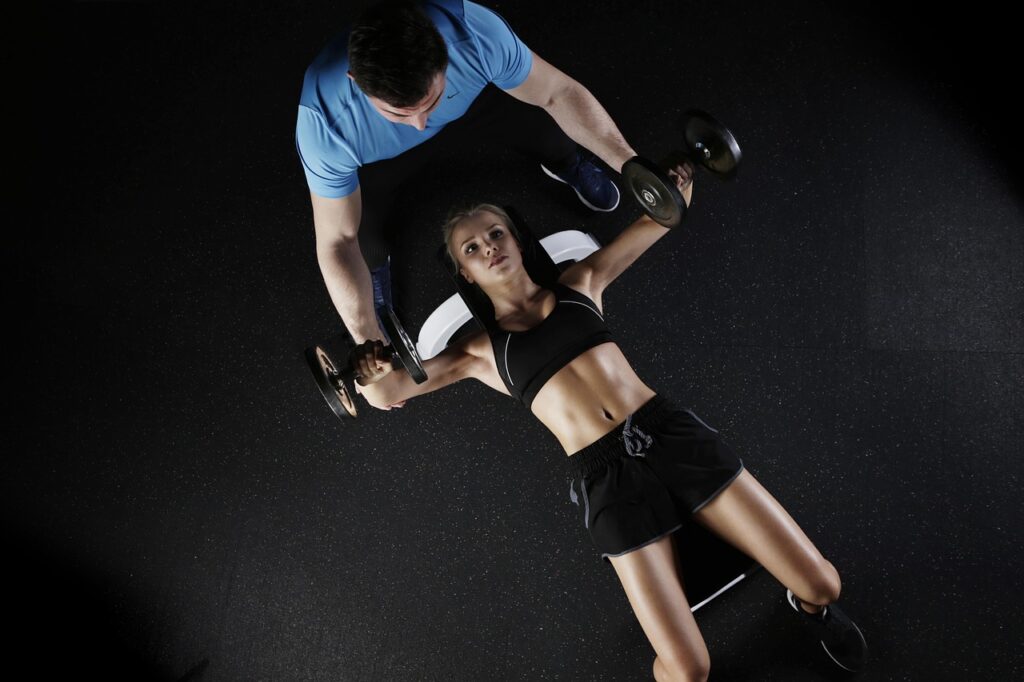
Pros and Cons of Training for Hiking at the Gym
When it comes to training for hiking and trekking, the first idea that springs to mind would be to hit the trails, starting with easy walks and gradually increasing the distance, duration, and difficulty.
However, trail hiking isn’t always feasible for building strength and endurance, especially for those with limited access to hiking areas or time constraints. In these cases, the gym offers a controlled environment where you can train specifically to become fitter, stronger, and better prepared for hiking.
Gym workouts complement hiking by allowing targeted muscle training, progressive strength development, and structured conditioning. For those who’re looking to get in better shape to hit the trail, here are over 20 of the very best gym exercises for hikers.

The Benefits of Exercising at the Gym to Train for Hiking
Training in a gym has several advantages for hikers aiming to build a comprehensive fitness base. Here are some of the benefits:
- Avoids Bad Weather: One of the greatest conveniences of training indoors is avoiding bad weather. You can exercise without worrying about rain, extreme heat, or icy conditions, which can be uncomfortable or even dangerous on hiking trails.
- Enables Heavier Training: Gyms are equipped with weights and machines that allow for controlled strength training with heavier resistance. This is particularly beneficial for building leg and core strength, both crucial for navigating steep terrain and carrying heavy backpacks.
- Allows for More Variety: A gym provides access to various types of equipment, enabling you to perform a range of exercises that target different muscle groups. From free weights to cardio machines, the variety helps keep workouts interesting and effective.
- Focused, Free from Distractions: Unlike outdoor settings where distractions like uneven paths or changing weather can disrupt your focus, a gym environment is controlled, allowing you to concentrate on your workout and form.
- Time Efficient, Convenient: For those with busy schedules, a gym workout is often quicker and more accessible than planning a hike. You can work out on your own terms, whether it’s early morning, late evening, or during lunch breaks.
Disadvantages of Exercising at the Gym to Train for Hiking
While there are clear benefits to gym training, it’s also important to consider some of the downsides:
- Missing Out on Nature: Hiking is a connection with nature, and a gym cannot replicate the sensory experience of being outdoors. Training indoors lacks the environmental challenges and fresh air that come with real hikes.
- Waiting for Machines When Busy: During peak hours, gyms can get crowded, leading to wait times for popular machines or equipment. This can disrupt your workout flow and reduce efficiency.
- Too Many Options: A gym’s plethora of equipment and machines can be overwhelming, especially for beginners. It may lead to unnecessary complexity or cause you to use machines that don’t directly benefit your hiking goals.
- Distracted with Unrelated Exercises: The gym environment, with its many options, can sometimes lead you to focus on exercises that aren’t as useful for hiking, such as those targeting isolated muscle groups with minimal relevance to trail conditions.
- Expensive: Gym memberships and personal training fees can be costly. For those who primarily hike and don’t regularly use gym equipment, the expense might not be justified.
The Ultimate List of Best Gym Exercises for Hikers
The following exercises are highly effective for hikers, aiming to build strength, endurance, and balance. These moves target essential muscle groups, improve joint stability, and enhance the cardiovascular fitness required for hiking.
Bodyweight Exercises
- Step Down: This move mimics downhill walking, strengthening the quads and improving balance. Stand on a step and slowly lower one foot to the ground, then return to the starting position.
- Single Leg Deadlift: Strengthens hamstrings, glutes, and core, which helps with stability on uneven trails. Balance on one leg, hinge forward, and lower your torso while extending the opposite leg behind you.
- Lateral Slider Lunge: Engages the glutes, hips, and inner thighs for lateral stability. Place one foot on a slider and slide it out to the side while performing a squat on the stationary leg.
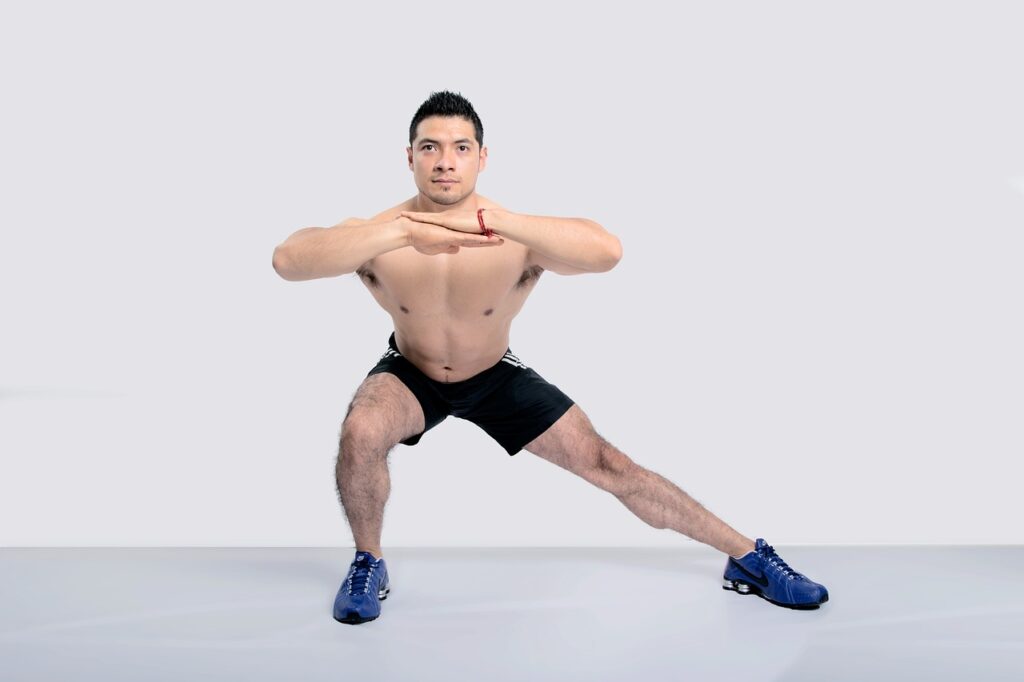
Barbell Exercises
- Barbell Glute Bridge: Targets the glutes and hamstrings, building power for uphill climbing. Lie on your back with knees bent, place a barbell across your hips, and lift your hips toward the ceiling.
- Front Squat: Strengthens the quads, core, and lower back. With a barbell across your shoulders, perform a squat while keeping your chest up and core engaged.
- Barbell Step Up: Similar to a regular step-up but with added weight, this exercise improves leg strength and balance. Step up onto a platform with a barbell on your shoulders and lift the opposite leg.

Dumbbell Exercises
- Hack Squat: Focuses on quad strength, which is essential for both ascents and descents. Hold a dumbbell behind your body with both hands and squat down, keeping the chest lifted.
- Dumbbell Calf Raise: Strengthens the calves, helping to prevent fatigue on long hikes. Hold dumbbells by your sides and lift your heels off the ground, balancing on the balls of your feet.
- Eccentric Goblet Squat: Targets the legs and core while improving balance. Hold a dumbbell at chest height and squat slowly, emphasizing the lowering (eccentric) phase.
Gym Machine Exercises
- Single Leg Calf Raises on Leg Press: Strengthens the calves, enhancing stability on steep terrain. Place one foot on the leg press platform, press up onto your toes, and then lower down.
- Seated Calf Raise Machine: Focuses on calf strength and endurance. Use the machine to perform calf raises, engaging the lower legs for stability and shock absorption on rough trails.
- Single Legged Leg Press: This exercise targets the quads, glutes, and hamstrings. It mimics the pushing motion of climbing, strengthening each leg individually.
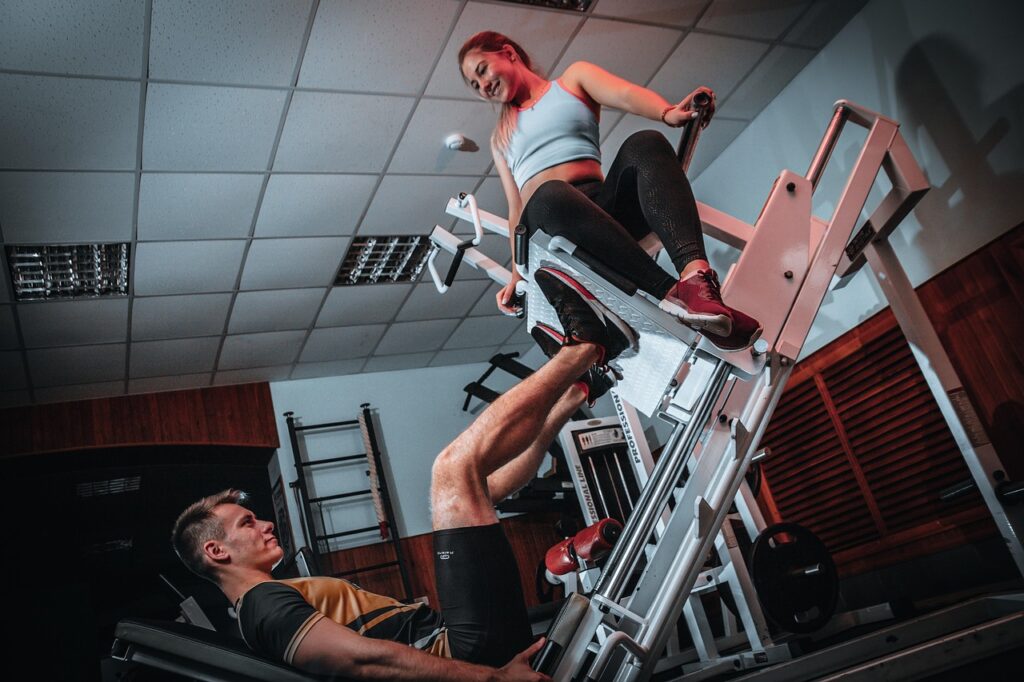
TRX Exercises
- Pistol Squat: Works the entire lower body and challenges balance. Hold the TRX straps for support, perform a single-leg squat, and keep the other leg extended forward.
- TRX Row: Builds upper back and core strength for carrying a backpack. Hold the TRX handles and pull your chest toward the anchor point, keeping your body straight.
- TRX Skater Squat: Improves leg strength and lateral stability. Hold the TRX handles, squat on one leg while moving the other leg back in a curtsy lunge motion.

Upper Body Exercises
- Seated Cable Row: Strengthens the upper back and shoulders, preparing you for the load of a backpack. Sit at a cable machine, pull the handles toward your chest, and engage your back muscles.
- Half Kneeling Overhead Press: Engages the shoulders, core, and improves balance. Kneel on one knee, press a dumbbell overhead, and switch sides.
- Neutral Grip Dumbbell Chest Press: Builds upper body strength. Lying on a bench, hold dumbbells with a neutral grip and press them up, engaging the chest and arms.
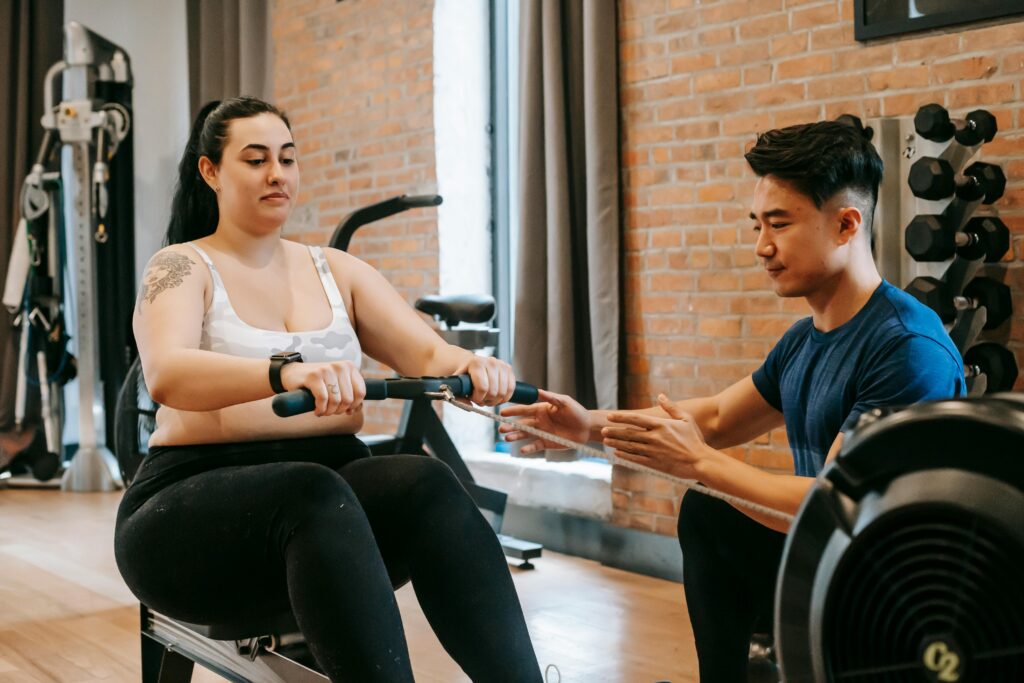
Gym Cardio Exercises
- Stepper: Mimics climbing stairs, making it ideal for building leg endurance. Use the stepper to increase stamina and leg power for uphill sections.
- Stationary Bike: Enhances cardiovascular fitness and leg endurance. The bike provides a low-impact way to build stamina for longer hikes.
- The Sled: Pushing or pulling a sled builds lower body strength and endurance, essential for carrying loads and handling uneven surfaces.
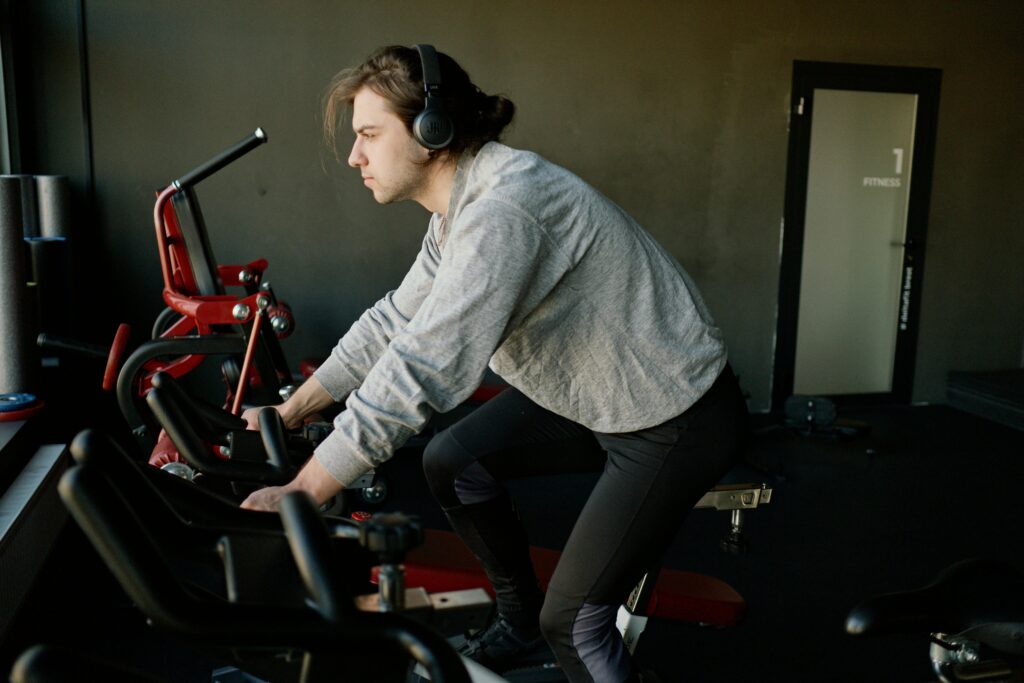
Core Exercises
- Dumbbell Deadbug: Strengthens the core and helps maintain stability on rough trails. Lie on your back, hold a dumbbell, and extend opposite arm and leg, alternating sides.
- Suitcase Carry: Improves core strength and balance. Hold a heavy dumbbell on one side, keep your core tight, and walk forward without leaning to one side.
- Cable Pallof Press: Builds core stability by resisting rotation, which is important for maintaining balance on unstable terrain. Attach a cable at chest height, hold it with both hands, and press it forward, resisting the cable’s pull.
Where to Next?
- Ultimate Guides – your gateway to hiking across Europe
- Hikes & Trails – curated lists of the best hikes and local gems
- Walking Holidays – extended journeys for when a single day just isn’t enough
- General Blog – all the extras: gear reviews, planning tips, and personal stories
In Conclusion
Training at the gym is a powerful way to prepare for hiking, as it allows you to target specific muscle groups and improve stamina, strength, and balance. A structured gym routine that includes exercises for the lower body, core, upper body, and cardiovascular endurance can significantly enhance your hiking experience.
By building a solid fitness foundation, you’ll be better equipped to handle the physical demands of various trails, reduce your risk of injury, and enjoy the journey more fully. Whether you’re a beginner or a seasoned hiker, incorporating the best gym exercises for hikers into your weekly routine, you can elevate hiking performance and give you the confidence to tackle new challenges in the great outdoors.

